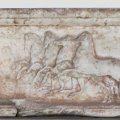The world’s best athletes may steal the spotlight at the Olympic Games in Beijing, but sporting champions from 2500 years ago still live on at the University of Queensland.
The R D Milns Antiquities Museum houses several Olympics-related artefacts in its collection, and is open free to the public throughout the Games.
Lecturer in Classics and Ancient History and museum curator Dr Sonia Puttock said interesting items on show included a fragment of a kylix, or Athenian clay drinking cup depicting a long jumper and a Greek silver coin from 360 BC showing two wrestlers locked in competition.
Like many Ancient Olympic sports, the long jump has changed over time, with athletes originally leaping from a stationary position with the help of weights which they swung and released to gain momentum.
UQ Cultural History Project member and Olympics expert Dr David Pritchard said the museum contains several valuable objects which depict ancient sports or were used by athletes training for the Olympics or other sporting festivals of the time.
“Among these captivating pieces are bronze strigils, which were used by athletes to remove sweat and dirt from their bodies after their training sessions, and tiny spherical containers, called aryballoi, which once contained the olive oil sportsmen applied before training and competing in local and international games,” he said.
Dr Puttock said the Ancient Olympics were an important religious festival to honour Zeus of Olympia and attracted athletes from right across the Mediterranean for competition in a wide range of track and field and combat events.
“Ancient Greece was a variety of city states, so to win at the Olympic Games was very important as your name and the name of your state took the honour. It’s the same today really,” she said.
And in another parallel to modern day competition, cheating sportsmen from 2000 years ago were named and shamed with the erection of zanes – statues of Zeus whose base was inscribed with the offender’s details.
“Of course the inscription would say who they were and where they came from, so the city state was also targeted,” Dr Puttock said.
“So we still look at those today and we know they cheated - if you look at the site of Olympia you can still see them today.”
The Ancient Olympic Games were staged every four years from 776 BC and until 393AD, with the first Olympic Games of the modern Olympic Movement taking place in Athens in 1896.
The R D Milns Antiquities Museum is located on the third floor of the Michie Building, St Lucia, and is open free to visitors from 9am – 5pm Monday to Friday (no bookings required).
Media: Dr Puttock (07 3355 2191, s.puttock@uq.edu.au), Dr Pritchard (0401 955 160, 07 3365 3338, d.pritchard@uq.edu.au) or Cameron Pegg at UQ Communications (07 3365 2049, c.pegg@uq.edu.au)
.jpg)



